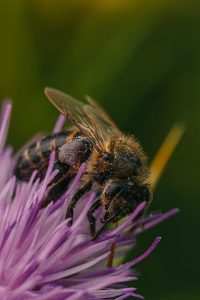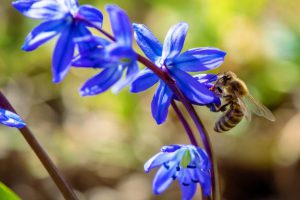Replacement Queens, A True Cinderella Story
Honey bee colonies and beekeepers alike can’t afford to take queen rearing lightly. During supercedure events, swarm preparation, or emergency queen replacement, nurse bees must reach a quick consensus on which female larvae will receive royal care. Two recent articles from leading bee scientists offer contrasting views for how that choice is made. Ramesh Sagili and colleagues suggest that nurse bees make an economic choice, by tending to invest in well-fed young larvae as their future queens. Presumably, young female larvae that are large for their age will develop into more robust queens. Sagili and colleagues starved clusters of first-instar female larvae for four hours by blocking out nurse bees with a mesh screen. They then placed combs containing these clusters, alongside clusters of larvae that had been fed normally, into colonies that were ready to raise a replacement queen. Food-deprived larvae, while still viable, were far less likely to be picked as replacement queens. Interestingly, the discrimination against skinnier larvae was not observed when starved and normal larvae were placed into queen cups, suggesting that the stimulus of these cups outweighed any cues nurses might use to pick the most queen-worthy larvae. As further evidence that nurse bees can smell starvation, or that starving larvae tend to beg more for food (or both), larvae that had been deprived of food were fed more often and for longer periods. Thus, nurse bees did their best to get these larvae caught up in terms of worker development, despite tending to pass them over as future queens. Their work is described in “Honey bees consider larval nutritional status rather than genetic relatedness when selecting larvae for emergency queen rearing”, Scientific Reports 8:7679, https://www.nature.com/articles/s41598-018-25976-7, 2018.
This and other experiments suggest that physical cues and/or chance are the main forces driving which larvae are chosen for the queen route, but this need not be the case. Much thought and work have gone into testing whether there might be a birthright for royalty. This could come in two ways. First, since queen bees mate prolifically, most females in the nest are only half-sisters. If a nurse bee had the power to choose a full sister as the next queen, this nepotistic act would benefit her greatly (especially since the dads of full or ‘super’-sisters are haploid and hence give an exact version of themselves to all of their daughters, a tale for another day). As appealing as nepotism seems, it is not a frequent occurrence in bee colonies, arguably because a nepotistic trait would lead to poor queen regulation over time, if not outright battle. There is another way for a genetic bias to present itself. Perhaps there are blue-blooded lineages of honey bees whose members inevitably aim for a royal seat. This, too, can lead to an unstable state, where successful royalty begets more royalty until the ratio of queen-destined larvae gets out of whack, at its extreme leading to dozens of feuding royals and not a lot of stinging or foraging. Still, when this trait is rare there is an opportunity for such royalty genes to hang around.
James Withrow and David Tarpy present strong evidence for ‘royalty’ lineages in honey bees. Using a form of DNA fingerprinting, they show a tendency for some lineages to be over-represented as queens (“Cryptic ‘royal’ subfamilies in honey bee (Apis mellifera) colonies” PLoSONE 13(7):e0199124, https://doi.org/10.1371/journal.pone.0199124, 2018). Chosen royals are extremely rare, and in fact the authors propose that queen bees are even more promiscuous than currently thought, and some of the most rare lineages (patrilines) show this royal bias. So how does this trait arise and why don’t royal lineages predominate? Mechanistically, royal-leaning larvae must attract special attention from nurse bees, perhaps like the starved larvae above, but without going through starvation. Since nepotism is not involved, these ‘feed-me-well’ cues must be perceived by average nurse bees. The authors argue that the other forms of queen replacement, namely supercedure and pre-swarming, slow the rise of royal lines. Here, queen-destined larvae are laid in preformed queen cells and it seems implausible that a queen aspirant could determine her own birth order in such a way as to land in a queen cell.
A true fairy tale skips over the gritty details, but if you are interested in which changes occur inside chosen queens when they start on a royal path, numerous scientists have tackled this. One way involves measuring how larvae turn on specific genes that lead to the proteins best suited for royalty or a life of work. Xu-Jiang He and colleagues have provided a complete view of these caste-biased genes in their recent paper, “A comparison of honeybee (Apis mellifera) queen, worker and drone larvae by RNA‐Seq” in Insect Science, https://onlinelibrary.wiley.com/doi/full/10.1111/1744-7917.12557, 2017). This topic is fascinating to me personally and in fact is the very question that brought me into bees 20+ years ago. Diana Wheeler, Gloria deGrandi-Hoffmann and I recount the ways specific genes can lead to queens or workers in “Honey bee queen production: Tight genes or too much food?” American Bee Journal, 140(2), 136-137, 2000). The next time you induce a queen event in your colonies, or watch as one unfolds, remember the many forces inside new queens and their nestmates that can affect the outcome.
Jay Evans is the Research Leader for the USDA Honey Bee Lab in Beltsville, MD.










